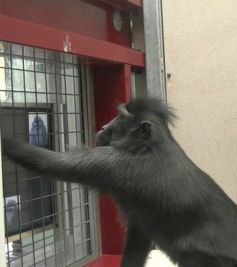Touch Screens Help Monkeys Relax (Op-Ed)


This article was originally published at The Conversation. The publication contributed the article to LiveScience's Expert Voices: Op-Ed & Insights.
Zoos are great places to study animals. The non-human primates among them get the most attention from researchers. Some of them are trained to interact with computers for psychological research. In a new study, we show that such training can provide benefit to them – it can help some monkeys relax.
Studying animals in the wild is demanding, but important. Zoo-based research makes the task easier, but it also means that scientists can ask questions which are difficult to answer from the observation of animals in the wild. We wanted to find out how experimental research can affect a group of crested macaques at Marwell Wildlife.
Non-human primates are good models for studying psychology because of their intelligence and close relationship to us. The dexterity of their hands helps them use devices similar to those of humans. At Marwell Wildlife, monkeys take part in matching tasks on a computer touch screen.
To take part, the monkeys leave their social group voluntarily and can then return to their group whenever they wish. In a study published in PLOS ONE, our team at the University of Portsmouth found that the temporary separation of individuals from their social group seems to have a positive effect on them.
This could be because dominant individuals left their group, allowing the others to integrate themselves better and become more friendly. In wild macaques it is common for a large group to split into smaller groups, where a few individuals will leave the main group and return later. It seems that providing the captive macaques with an opportunity to leave their group mates caused them to replicate different behaviours which are usually observed in the wild, but in a much smaller scale (area, group size and time spent).
The macaques we studied seemed friendlier too, after they had had a chance to interact with the computer. One of the ways crested macaques manage their social relationships is through a friendly gesture, the lipsmack. This is where they purse their lips and move the lower jaw up and down rapidly. The higher rate of lipsmacking we observed among this group of macaques suggests there was increased harmony and cohesion in the group.
Get the world’s most fascinating discoveries delivered straight to your inbox.
When they left the group to use touch screens we found there were far fewer conflicts. This might mean that we were giving the lower ranking group mates, who are usually the main recipients of any aggression, a break from fighting.
It is probably not only the separation of individuals, but also the reunion of individuals back into a group that may be important when maintaining social bonds and reaffirming friendships. The macaques tended to group together more when they took part in our experiments, suggesting that the individuals were co-ordinating with each other better and forming a more cohesive group. Similar behaviours are observed in the wild, where the animals are excited by the reformation of their social group.
If we wish to study captive animals in this way, it is crucial to analyse the effects of the research on these animals. There are important animal welfare considerations (we do not want to harm our subjects and are trying to enrich their environment where possible), but also important scientific considerations. Animals under any amount of psychological stress may behave unusually, so if our subjects are stressed we may not be seeing them in their true light.
Learning about animal cognition requires that our subjects are as stress-free as possible. Using touch screens seems to help that goal.
Jamie Whitehouse does not work for, consult to, own shares in or receive funding from any company or organisation that would benefit from this article, and has no relevant affiliations.
This article was originally published at The Conversation. Read the original article. The views expressed are those of the author and do not necessarily reflect the views of the publisher. This version of the article was originally published on LiveScience.



